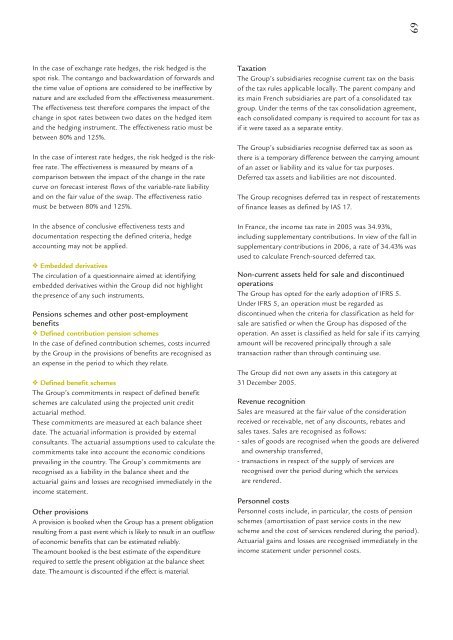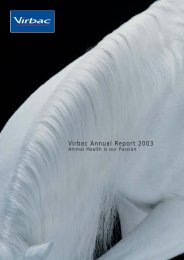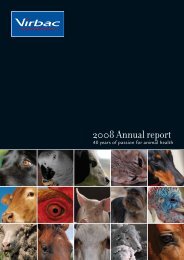2005 Annual report - Virbac
2005 Annual report - Virbac
2005 Annual report - Virbac
Create successful ePaper yourself
Turn your PDF publications into a flip-book with our unique Google optimized e-Paper software.
69<br />
In the case of exchange rate hedges, the risk hedged is the<br />
spot risk. The contango and backwardation of forwards and<br />
the time value of options are considered to be ineffective by<br />
nature and are excluded from the effectiveness measurement.<br />
The effectiveness test therefore compares the impact of the<br />
change in spot rates between two dates on the hedged item<br />
and the hedging instrument. The effectiveness ratio must be<br />
between 80% and 125%.<br />
In the case of interest rate hedges, the risk hedged is the riskfree<br />
rate. The effectiveness is measured by means of a<br />
comparison between the impact of the change in the rate<br />
curve on forecast interest flows of the variable-rate liability<br />
and on the fair value of the swap. The effectiveness ratio<br />
must be between 80% and 125%.<br />
In the absence of conclusive effectiveness tests and<br />
documentation respecting the defined criteria, hedge<br />
accounting may not be applied.<br />
❖ Embedded derivatives<br />
The circulation of a questionnaire aimed at identifying<br />
embedded derivatives within the Group did not highlight<br />
the presence of any such instruments.<br />
Pensions schemes and other post-employment<br />
benefits<br />
❖ Defined contribution pension schemes<br />
In the case of defined contribution schemes, costs incurred<br />
by the Group in the provisions of benefits are recognised as<br />
an expense in the period to which they relate.<br />
❖ Defined benefit schemes<br />
The Group’s commitments in respect of defined benefit<br />
schemes are calculated using the projected unit credit<br />
actuarial method.<br />
These commitments are measured at each balance sheet<br />
date. The actuarial information is provided by external<br />
consultants. The actuarial assumptions used to calculate the<br />
commitments take into account the economic conditions<br />
prevailing in the country. The Group’s commitments are<br />
recognised as a liability in the balance sheet and the<br />
actuarial gains and losses are recognised immediately in the<br />
income statement.<br />
Other provisions<br />
A provision is booked when the Group has a present obligation<br />
resulting from a past event which is likely to result in an outflow<br />
of economic benefits that can be estimated reliably.<br />
The amount booked is the best estimate of the expenditure<br />
required to settle the present obligation at the balance sheet<br />
date. The amount is discounted if the effect is material.<br />
Taxation<br />
The Group’s subsidiaries recognise current tax on the basis<br />
of the tax rules applicable locally. The parent company and<br />
its main French subsidiaries are part of a consolidated tax<br />
group. Under the terms of the tax consolidation agreement,<br />
each consolidated company is required to account for tax as<br />
if it were taxed as a separate entity.<br />
The Group’s subsidiaries recognise deferred tax as soon as<br />
there is a temporary difference between the carrying amount<br />
of an asset or liability and its value for tax purposes.<br />
Deferred tax assets and liabilities are not discounted.<br />
The Group recognises deferred tax in respect of restatements<br />
of finance leases as defined by IAS 17.<br />
In France, the income tax rate in <strong>2005</strong> was 34.93%,<br />
including supplementary contributions. In view of the fall in<br />
supplementary contributions in 2006, a rate of 34.43% was<br />
used to calculate French-sourced deferred tax.<br />
Non-current assets held for sale and discontinued<br />
operations<br />
The Group has opted for the early adoption of IFRS 5.<br />
Under IFRS 5, an operation must be regarded as<br />
discontinued when the criteria for classification as held for<br />
sale are satisfied or when the Group has disposed of the<br />
operation. An asset is classified as held for sale if its carrying<br />
amount will be recovered principally through a sale<br />
transaction rather than through continuing use.<br />
The Group did not own any assets in this category at<br />
31 December <strong>2005</strong>.<br />
Revenue recognition<br />
Sales are measured at the fair value of the consideration<br />
received or receivable, net of any discounts, rebates and<br />
sales taxes. Sales are recognised as follows:<br />
- sales of goods are recognised when the goods are delivered<br />
and ownership transferred,<br />
- transactions in respect of the supply of services are<br />
recognised over the period during which the services<br />
are rendered.<br />
Personnel costs<br />
Personnel costs include, in particular, the costs of pension<br />
schemes (amortisation of past service costs in the new<br />
scheme and the cost of services rendered during the period).<br />
Actuarial gains and losses are recognised immediately in the<br />
income statement under personnel costs.








